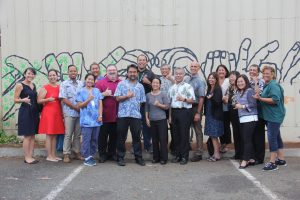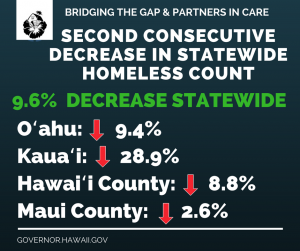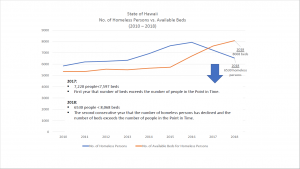Housing strategies get results for homelessness
Posted on May 30, 2018 in Featured
Governor Ige celebrates with the homelessness leadership team and service providers at the Kaka’ako Family Assessment Center’s first anniversary.
Three years ago, Governor Ige appointed Scott Morishige to be the state homelessness coordinator at a time when the Kaka‘ako encampment was at its largest, a legislator had been assaulted there, and some shelters were 50 percent empty. “As a community, we had a lot of work to do. The governor made addressing homelessness a priority,” he said. “This administration has focused on a Housing First model as a way to address the issue, and we’re seeing significant results.”
Morishige said revamped contracts for homeless services tied funding to housing-related outcomes and fundamentally changed the way people get help. Service providers are now being compensated for placing people in housing and retaining housing rather than simply providing a bed in a shelter. When the administration created the Family Assessment Center in Kaka‘ako, the governor wanted to see people transition to permanent housing in 90 days or less. The FAC has actually surpassed that goal, with 90 percent of families moving into permanent homes.
“Those are the types of outcomes we want to see,” Morishige said. “Our work isn’t flashy, but the results validate the process.” That’s why it’s frustrating to him when people see tents and think nothing is being done or no progress is being made. “Homelessness is complicated and it doesn’t seem rational. Why would anyone choose to live on the streets? Often, there are mental health and substance abuse issues, and this administration has devoted more resources to those services,” he said.

The 2018 Point in Time count shows a statewide decline in homelessness for the second consecutive year.
While Morishige is aware of the public’s frustration and resentment at seeing the homeless live in public spaces, he said it’s important to understand that they have legal rights, and the state must protect them. “We can’t force someone to accept shelter or services,” he explained. “We have to take the time to learn what their needs are and work with them to meet those needs. It’s often a lengthy process.”
He said with legislative support, “We were able to expand Housing First and existing services for the first time to the neighbor islands. Now we’re starting to see the results of hard work by many people.” The latest Point-in-Time count conducted by Partners in Care and Bridging the Gap shows a decrease in the number of people experiencing homeless statewide for the second straight year.
And what about the $30 million the legislature appropriated for ‘ohana zones? Morishige said although the administration testified before the legislature about having reservations about “safe zones” as a homeless strategy, he’s grateful that the final bill gave some flexibility for interpretation. However, it calls for six “safe zones” to be created — three on O‘ahu and one each in the counties of Kaua‘i, Hawai‘i and Maui, and the funding is good for only one year.
“We’ll have to see if it’s possible to leverage resources and collaborate with the counties and the private sector to maximize funding. It could be hard to build something from scratch,” he said. “The solutions will likely take different forms, depending on the community.
